Fire Statistics Scotland 2012-13
Statistical bulletin providing statistics on the incidents that Scotland's Fire and Rescue Services attended in 2012-13.
4. Commentary
This year the publication contains provisional data for 2012-13. These figures are still to be finalised but they provide a more timely aspect than was previously possible to publish. It is important to remember when using these figures that they are provisional and that they may be amended in future publications. This is especially true of casualties (see section 6.3.1 for revisions policy).
The figures for 2010-11 and 2011-12 have been revised and the figures provided here supersede those in the previous publications, and should be used in the reporting of fire statistics for Scotland.For all Scotland level tables, figures are provided to cover a minimum of ten years. At FRS level, the tables are only produced for the most current financial year. There are additional datasets available that provide revised trend figures for the key statistics at FRS level over ten years at: http://www.scotland.gov.uk/Topics/Statistics/Browse/Crime-Justice/Datasets/DatasetsFire
4.1 Total number of fires (Tables 1 and 1a)
In this publication, fires are classed as Primary, Secondary or Chimney.
Primary fires include all fires where one or more apply:
i) in non-derelict buildings, or in vehicles or outdoor stores
ii) any fire involving casualties, rescues,
iii) fires attended by five or more appliances.
In this publication, primary fires are usual split into 4 sub-categories: Dwellings, Other Buildings, Road Vehicles and Others.
Secondary fires cover the majority of outdoor fires including grassland and refuse fires unless they involve casualties or rescues, property loss or 5 or more appliances are in attendances.
Chimney fires are any fires in buildings where flame was contained within the chimney structure and did not involve casualties, rescues or attendance of 5 or more appliances.
In Scotland in 2012-13 Scotland's FRSs attended 26,613 fires, of these 42 % were primary fires 53 % were secondary fires and 5 % were chimney fires.
The total of all fires attended (primary, secondary and chimney fires) in Scotland for 2012-13 was 18 % lower than the revised figure of 32,336 fires recorded in 2011-12.
The number of primary fires in 2012-13 was 11,045, a decrease of 11 % from the 2011-12 revised figures of 12,417. Within primary fires for 2012-13, the highest proportion were dwelling fires (53 %), followed by other buildings (22 %), fires in road vehicles (18 %) and other primary fires (7 %). The 2012-13 figures are the lowest number of primary fires in the last ten years.
Between 2011-12 and 2012-13, secondary fires decreased by 24 % from 18,676 to 14,196 and chimney fire figures increased by 10 % from 1,243 to 1,372.
The total number of fires in 2012-13 (26,613) was the lowest value in the last decade. However there have been some large changes in the number of fires within each category. The number of secondary fires in 2012-13 has decreased by 56 % from 2006-07. As secondary fires are the highest proportion of total fires, changes within this category will have a major influence over the total number of fires in Scotland. This year the 24 % decrease in secondary fires (4,480) has contributed
78 % of the overall decrease in all fires (5,723) between 2011-12 and 2012-13. (Chart 2).
Chart 2 - Fires by location, Scotland 2002-03 to 2012-13 1
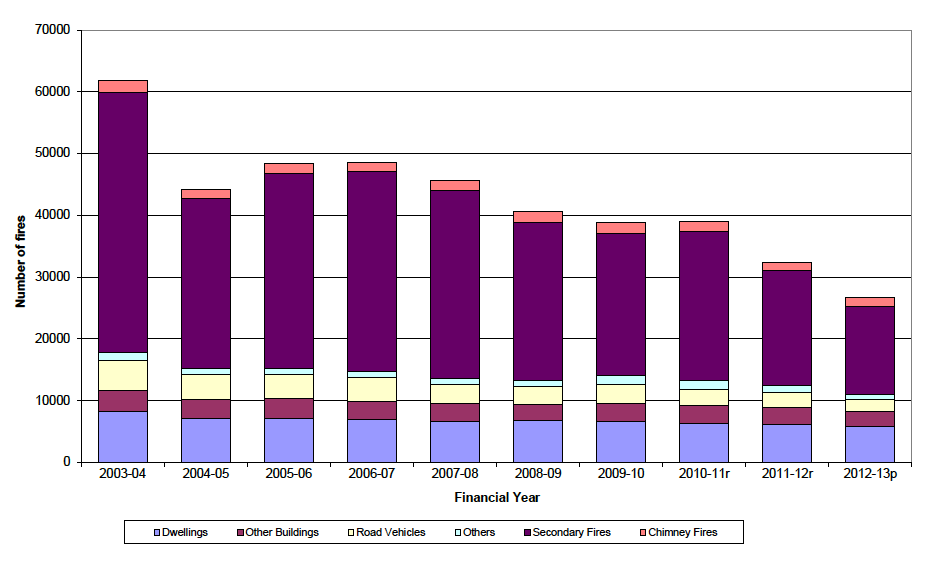
Notes:
p - provisional
r - revised
1 - figures before 2009-10, for primary fires are based on sample data weighted to Fire and Rescue Service level
4.2 Casualties by location (Tables 2, 2a, 3 & 3a)
Casualties from fire are split into 2 categories: fatal and non-fatal.
- A fatal casualty is where a person's death is attributed to a fire, even if the death did not occur at the time of the incident.
- Non-fatal casualties consist of persons who were
- given first aid at the scene of the fire
- taken to hospital to see a doctor for injuries (appeared to be either serious or slight)
- advised to see a doctor for a check-up or observation (whether or not they actually did). People sent to hospital or advised to see doctors as a precaution, having no obvious injury, are recorded as "precautionary check-ups".
All casualty data is provisional and may be revised, for example after fire investigations or medical reports. Please see section 6.3.1 for more details of the revision policy.
In Scotland in 2012-13 there were provisionally 46 fatal casualties from primary fires, a decrease of 14 from the revised figure of 60 in 2011-12. Of the provisional fatalities for 2012-13, 41 were in dwelling fires and 37 of those were in accidental dwelling fires.
The provisional figure for fatal casualties from primary fires is the joint lowest in the last decade. Fatal casualties from dwelling fires and accidental dwelling fires are the second lowest figures in the last decade.
In the previous year, 2011-12, there were originally 57 fire fatalities reported in the provisional publication, but this figure has been revised to 60 in this publication. There were a number of incidents where fire investigations were on-going at the time of last year's publication. The results of these investigations are the reason for the increase in the number of fire fatalities. The 2011-12 figures are now the fourth lowest in a decade rather than third lowest, as reported in the previous publication. The 2010-11 figures have also been finalised at 52, there was no revision to this number from last year.
In 2012-13, there were provisionally 1,311 non-fatal fire casualties. This is a decrease of 7 % on the revised 2011-12 figure of 1,415.
The highest number of non-fatal casualties in 2012-13 occurred in dwellings fires (1,164 or 89 %), 1,014 of which occurred in accidental dwelling fires. The number of non-fatal casualties (excluding precautionary check-ups) in primary fires was 993, a decrease of 10 % from 2011-12.
The provisional rate for fatal casualties was 7.4 per 1,000 accidental dwelling fires in 2012-13. This is the second lowest rate over the reported ten year period for this publication (Chart 3). This year the rate is lower than the ten year average of 8.7. (The ten year average shows that approximately 9 people die for every thousand accidental dwelling fires in Scotland.)
Chart 3 - Fatal casualties rate per 1,000 accidental dwelling fires, Scotland, 2003-04 to 2012-131
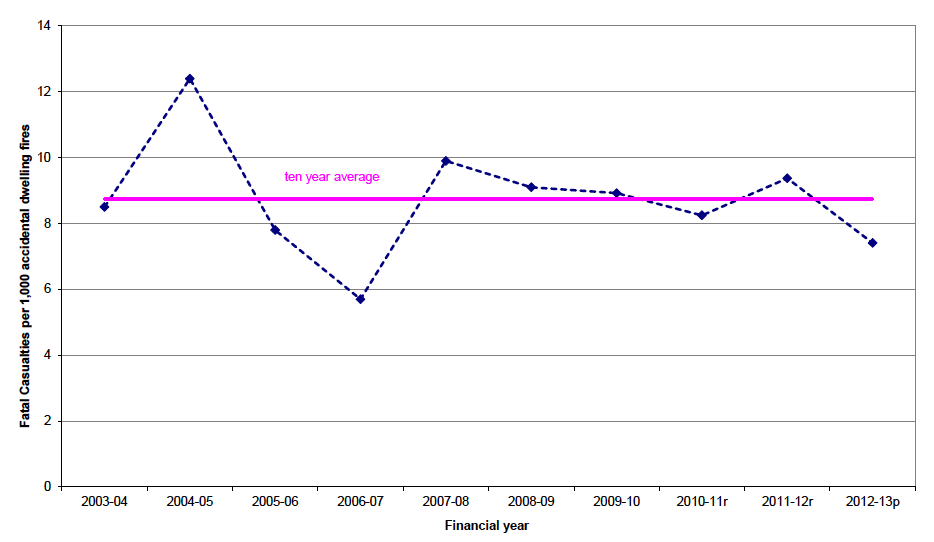
Notes
p - provisional
r - revised
1 - before 2009-10, figures for primary fires are based on sample data weighted to Fire and Rescue Service totals
4.3 False alarms (Tables 4, 4a, 4b, 4c, 4d, 5 and 5a)
In 2012-13, Scotland's FRSs attended 47,678 false alarms. Of these 99 % were fire false alarms (47,043) and the other 1 % were special service false alarms (635).
A false alarm is where the FRS believes they are called to a reportable incident and there is no incident. False alarms are categorised as follows:
Malicious: are calls made with the intention of getting the FRS to attend a non-existent incident, including deliberate and suspected malicious intent.
Good Intent: are calls made in good faith in the belief that the FRS really would be attending a fire or a special service.
Due to apparatus: are calls initiated by fire alarm and/or fire-fighting equipment (including accidental initiation of alarm apparatus by persons).
Fire false alarms are at their lowest for a decade. Over this period there has been a reduction of malicious fire false alarms from 13% of all fire false alarms in 2003-04 to 5% in 2012-13. The FRS activity that may have contributed to this reduction includes the FRS challenging the caller making these type of calls, and engaging in community youth engagement, etc.
Over the ten years there has been a steady increase in the proportion of false fire alarms that have been due to apparatus. Of all false fire alarms in 2012-13, 34,905 (74 %) were due to apparatus failure. The majority of fire false alarm due to apparatus were located in other buildings (70 %), i.e. not dwellings.
In 2012-13 the highest proportion of false fire alarms with good intent occurred in dwellings (39 %). There were 9,839 false fire alarms with good intent, which is
21 % of all false fire alarms for 2012-13.
Malicious false fire alarms accounted for 5 % (2,299) of total false fire alarms. This is the lowest figure for malicious false fire alarms reported in the last decade.
Of the 635 special service false alarms reported in 2012-13, 3 % were considered malicious and the rest (97 %) were raised with good intent.
4.4 Special service incidents (Tables 6, 6a, 6b, 6c and 7)
Special services are incidents that the FRS attend that are not fire related.
In 2012-13, the FRSs attended 9,130 special service incidents, a decrease of 10 % on the revised figures for 2011-12 (10,104). The highest proportion of these incidents were RTCs (road traffic collisions where a fire did not occur) at 25 % (2,255), followed by flooding at 15 % (1,348).
In just over half of all RTCs in Scotland in 2012-13, the FRS attended to make the vehicle safe or make scene safe (1,200) and 24 % of incidents required extrication of persons from vehicles (549).
Flooding incidents in 2012-13 have increased by 19 % (1,348) since 2011-12. The number of pumping out incidents has increased by about a third over the two years.
The biggest decrease in special services incidents between 2011-12 and 2012-13 was in the category "Making safe (not RTCs)". This decreased from 924 to 242. When this was examined more closely it was found that in December 2011 and January 2012, there were 415 incidents (44 %) in the sub-category "Stabilise or otherwise make safe unsafe structure". This coincided with very strong winds experienced in the central belt of Scotland over the festive period 2011-12.[2]
Special service incidents in 2012-13 represented 11% of all incidents (83,421) that FRSs attended (Chart 4). More casualties are associated with special service incidents than fire incidents. In 2012-13, Scotland's FRSs reported 195 provisional fatal casualties and 2,432 provisional non-fatal casualties from special service incidents. The highest percentages of these were in RTCs where there were 47% of fatal casualties and 73% of non-fatal casualties.
Chart 4: Proportion of type of incidents attend by FRSs in 2012-13 - Scotland
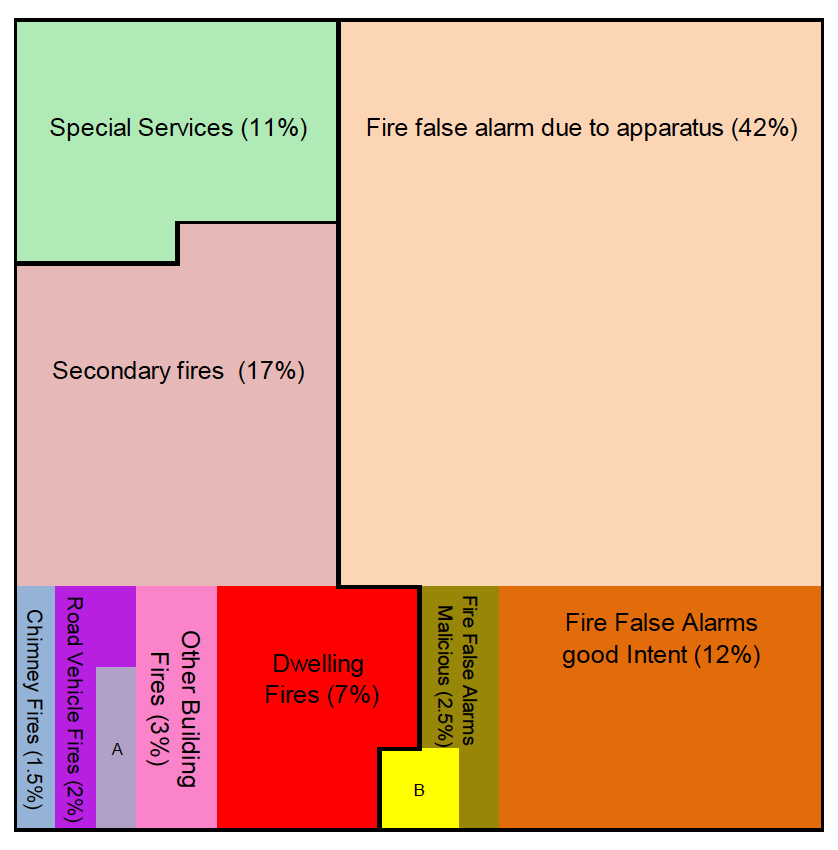
Notes
A - Other Primary Fires (1%)
B- Special Services False Alarms (1%)
Created on percentages of total incidents, percentage rounding may varied slightly to create this chart
It should be noted that there are other statistical reports of Road Traffic Collisions (RTCs) casualties and fatalities in Scotland. The publication 'Key Reported Road Casualty Statistics Scotland' contains details provided by police forces in Scotland. In that publication, for 2012 provisionally there were 170 fatalities and 12,405 injuries (serious and slight combined)[3] reported. Since the police can be considered to attend all RTCs and the FRSs attend only those where they are required, these police casualty figures will be higher than FRS figures. The FRSs' RTC casualty figures reported in this fire publication are a subset of the police figures and specifically represent the FRS activity.
4.5 Building fires (Tables 8 and 8a)
In 2012-13, a total of 8,201 building fires were recorded in Scotland, this is a decrease of 8 % from 2011-12 (8,879 building fires). This is the lowest value for over a decade. Of these building fires 71 % occurred in dwellings.
The 'Other building' sub-categories have changed since 2008-09 and reporting is now on these new categories. Of the 2,381 'Other buildings' fires, 20 %, were 'Other residential', 15 % were 'Private garages, sheds, etc' and 10 % were 'Industrial' and 'Retail'.
4.6 Outdoor fires (Tables 9 and 9a)
Primary outdoor fires have decreased by 20 % for 2012-13 (2,844) compared to 2011-12 (3,538). For the last ten years, road vehicle fires have represented the largest proportion of fires in this category, accounting for 71 % of all primary outdoor fires in 2012-13. Of the 2,032 vehicle fires in 2012-13, 56 % occurred in cars (not abandoned), 13 % occurred in abandoned vehicles and the rest occurred in other types of road vehicles (not cars) (30 %).
The number of secondary outdoor fires for 2012-13 has decreased by 24 % from 18,676 in 2011-12 to 14,196 in 2012-13. The most common category in secondary outdoor fires was refuse fires.
(The ten year trend data has been affected by changes in the recording system: previously there were 6 sub-categories of secondary fires and now there are over 100 (see section 6.5.3)).
The number of refuse fires in 2012-13 was 7,937, a decrease of 20 % from 2011-12 (9,934). Of these refuse fires, small /rubbish container fires (e.g. wheelie bins) accounted for 47 % whereas loose refuse and rubbish tip fires accounted for 45 % of secondary fires, whereas and 8 % were large rubbish containers (e.g. skips).
Between 2011-12 and 2012-13, secondary fires decreased by 4,480. Grassland fires and loose refuse/rubbish tip accounted for 40 % and 26 % respectively for this decrease.
Chart 5 shows secondary fires by month over the four years. In 2012-13, in general each month there fewer fires than previous years.
Chart 5 - Secondary fires, Scotland - 2009-10 to 2012-13p
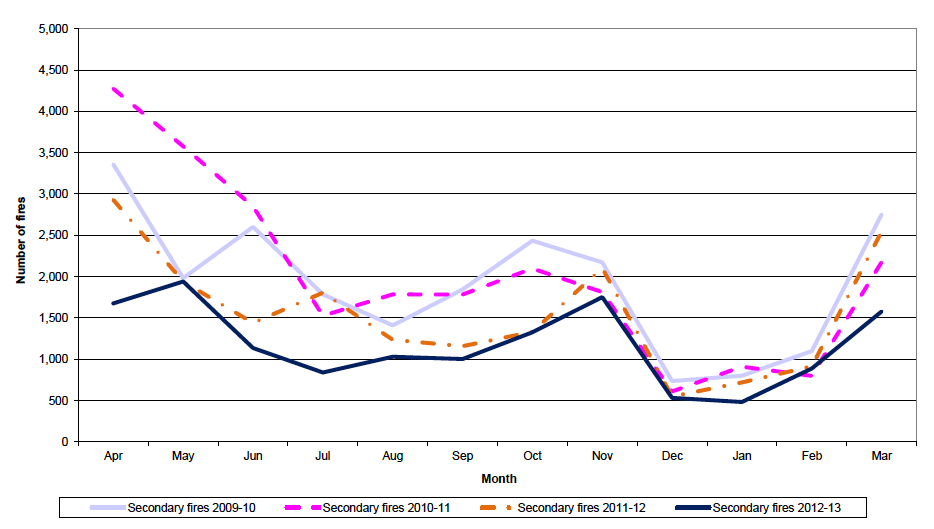
Note
This is taken from additional datasets provided on-line along with this publication .
4.7 Fire casualty numbers and rates (Tables 10, 10a, 10b, 11, 11a, 12, 12a, 12b, 12c, 12d, 13,13a, 13b, 13c, 13d, 14, 14a, 14b, 14c, 14d, 15, 15a, 15b, 15c and 15d)
At the time of this publication, the mid-year population figures from 2002 for England and Wales had been rebased (adjusted) to take account of the Census 2011 figures. For Scotland only the mid-year population figures have been rebased for 2011 and 2012.
In 2012-13, there were provisionally 46 fatal casualties in fires making the fatal casualty rate 8.7 fatalities per million population. This is the lowest rate in the last ten years.
However, the rate of fire fatal casualties per million population in Scotland at 8.7 was greater than England and Wales (5.1 and 5.5 respectively). Over the last ten years Scotland has continually had a higher fire fatality rate than the rest of Great Britain (Chart 6).
Chart 6 - Rate of fatal fire casualties per million population - Great Britain- 2003-04 to 2012-13
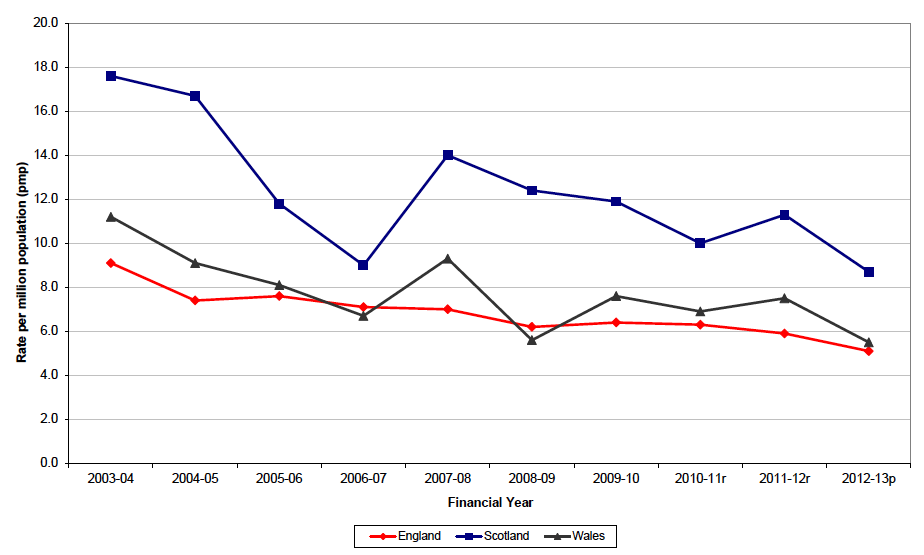
Notes
p - provisional
r - revised
This trend is found in the non-fatal casualties rates. In 2012-13, the rate for Scotland was 246.7 non-fatal casualties per million population, whereas in Wales it was 174.7 and in England it was 156.6. Scotland has had a consistently higher rate than England and Wales over the last ten years, even taking into account the change in reporting of non-fatal casualties from 2009-10 (see section 6.5.2ii for more details).
Casualties relating to gender
In 2012-13, 23 males and 23 females were fatal casualties in primary fires; this is the first time in ten years that number of males deaths were not higher than female.
The 2012-13 rate of fatal casualties per million population for males was 8.9 whereas females was 8.4. (Chart 7 - fatal casualties)
Chart 7 - Non-FRS personnel fire casualty rates per million population from primary fires - by gender, Scotland, 2003-04 to 2012-13p
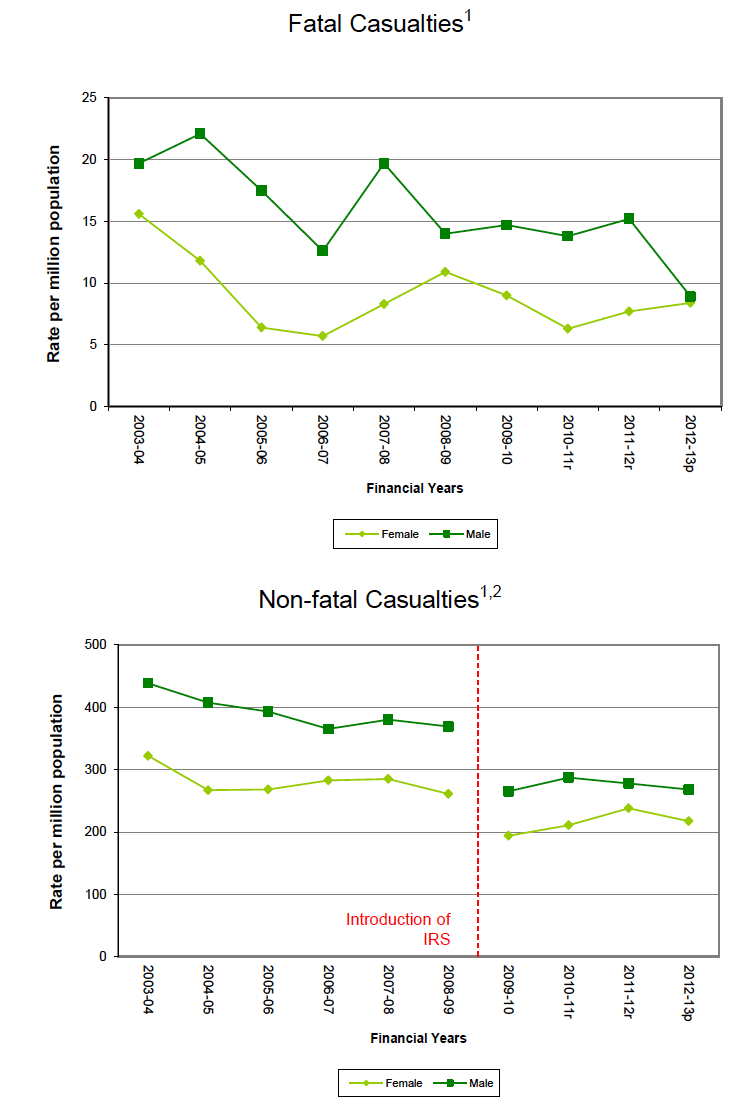
Notes for Chart 7
p - provisional
r - revised
1 - refers to persons who are not members of the fire and rescue service
2- there has been a change in the recording of non-fatal casualties and 2009-10 and beyond can no longer be compared to previous years - see section 6.5.2 ii
In 2012-13, there were provisionally 1,311 non-fatal casualties in primary fires (246.7 casualties per million population). Without the FRS personnel non-fatal casualties (16) there were 1,295 members of public (non-FRS) who were non-fatal casualties (242.0 casualties per million population).
In 2012-13, there were 691 males who were non-fatal fire casualties compared with 595 females (this excludes FRS personnel figures and where gender was unknown). Males are more likely than females to be injured in a fire and this has been a consistent trend over the last decade. The rate of non-fatal casualties per million population for males was 268.1, whereas females were 217.4. (Chart 7- non-fatal casualties).
There were 16 fatal casualties (35 %) in 2012-13 who were 'overcome by smoke, gas or fumes'. Similarly, this was the highest category for (non-FRS) non-fatal casualties at 40 % (524), followed by precautionary check-ups at 24 % (317). Of these non-fatal casualties, 494 members of the public were given first aid at the scene (38 %), 429 were sent to hospital with slight injuries (33 %), 317 were recommended precautionary checks (24 %) and 55 went to hospital with serious injuries (4 %).
Casualties relating to age
Of the 46 fatal casualties in 2012-13, there were 26 in the 60 and over age group, followed by 19 in the 30-59 year age group. The rate of fatal casualties was 20.8 per million population in the 60 and over age group, more than double the Scottish rate of 8.7, whereas the 30-59 age group rate was the same this year at 8.7. Throughout the last ten years the 60 and over age group has always had the highest rate of fatal casualties per million population. (Chart 8 - fatal casualties)
In 2012-13, the 30-59 year olds age range had the highest number of non-fatal casualties with 512 (41 %), (this excludes FRS personnel figures and where age was unknown), followed by the 60 and over age group with 386 (31 %). The age range of 60 and over age group has the highest rate of non-fatal casualties at 309.2 casualties per million population.(Chart 8 - non-fatal casualties). This year for the first time in a decade the 60 and over age range has the highest non-fatal casualties rate per million population within the 4 age groups.
Chart 8 - Non-FRS personnel fire casualty rates per million population from primary fires - by age range, Scotland, 2003-04 to 2012-13p
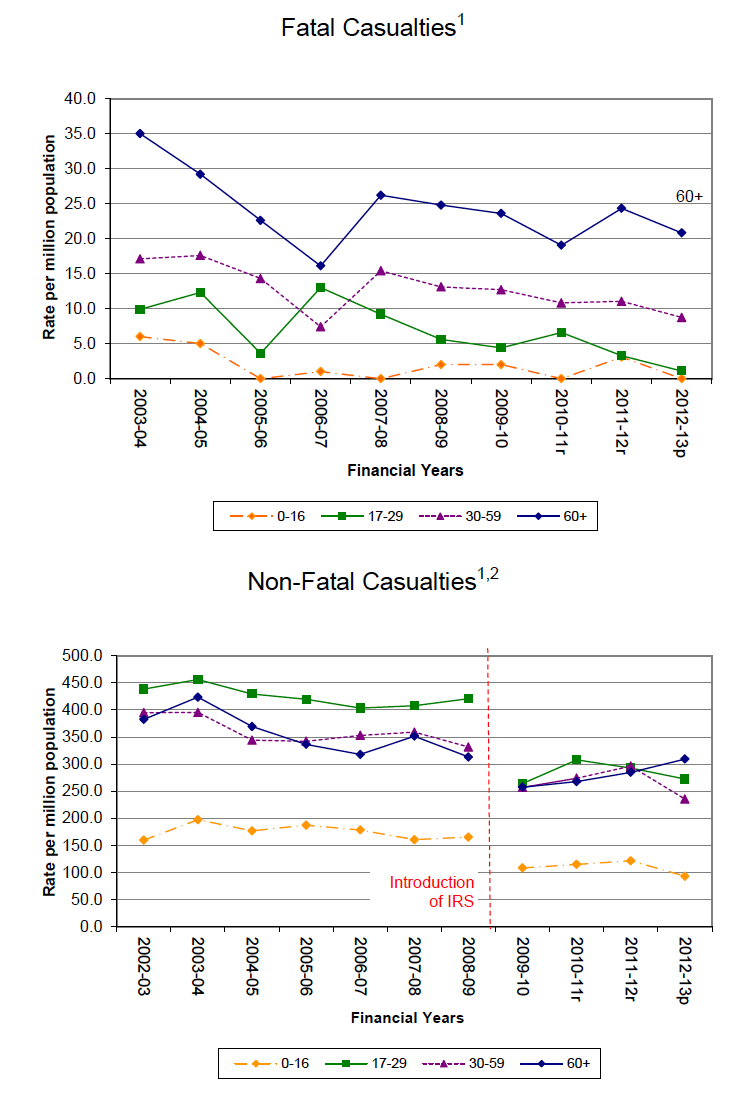
p - provisional
r - revised
1 - refers to persons who are not members of the fire and rescue service
2 - there has been a change in the recording of non-fatal casualties and 2009-10 and beyond can no longer be compared to previous years - see section 6.5.2ii
4.8 Rescues from fires (Tables 16, 16a and 16b)
The majority of rescues from fires are performed by FRS personnel, but sometimes other people can be involved in making the rescues. In 2012-13, there were a total of 785 rescues, 51 % of rescues involved a person who was a casualty and 49 % involved a person who was rescued but not injured.
The largest number of rescues involved persons who were in the age group of 30-59 years old (40 %) followed by the 60 and over age group (33 %).
The rate of rescues per million population for 2012-13 for Scotland was 147.7.
The 60 and over age group had the highest rate of rescue per million population at 207.5 and the lowest belong to the 0-16 age group at 62.5.
4.9 Deliberate and accidental fires (Tables 17, 18, 19 and 19a)
In 2012-13, there were 8,222 primary fires reported as accidental compared to 2,823 that were considered deliberate: 74 % and 26 % respectively. For 2012-13, the most common location for an accidental fire was in a dwelling (61 %). Accidental dwelling fires for 2012-13 are at their lowest level in the last ten years at 4,994. In the previous 9 years, the most common location for a deliberate fire was a road vehicle but this year it is dwellings. There were 826 deliberate dwelling fires compared to 814 deliberate road vehicle fires in Scotland in 2012-13.
There were provisionally 39 fatal casualties in accidental primary fires and 7 in deliberate primary fires in 2012-13. In accidental fires most fatal casualties occurred in dwellings (37). Fatal casualties from accidental primary fires are at their second lowest value in ten years.
There were provisionally 1,119 non-fatal casualties in accidental primary fires and 192 in deliberate primary fires in 2012-13. Again the majority of non-fatal casualties occurred in dwellings, 1,014 in accidental dwelling fires (91 %) and 150 in deliberate dwelling fires (78 %).
In 2012-13, there were 12,238 deliberate secondary fires (86 %) compared to 1,958 accidental secondary fires (14 %). Secondary fires have always had a much higher proportion of deliberate fires than primary. The majority of deliberate secondary fires involved refuse (58 %), followed by grassland (22 %). Within accidental secondary fires, refuse and grassland were also the most common types of fire, 43 % and 39 % respectively.
4.10 Smoke alarms (Tables 20 and 20a)
The presence of smoke alarms has always been reported in FDR1 data, but with the introduction of IRS a new category has been included i.e. 'Don't know if smoke alarm was present' (see section 6.5.3) - thus slightly affecting the comparability of these statistics prior to 2009-10.
In 45 % of primary dwelling fires in 2012-13 there was a smoke alarm present, that operated and raised the alarm (2,636).
For 2012-13, there were 1,801 dwelling fires (31 %) where a smoke alarm was absent and there were 96 dwelling fires (2 %) where it was not known if a smoke alarm was present.
Chart 9 - Primary fires in dwellings by smoke alarm presence and operation, Scotland - 2012-13p
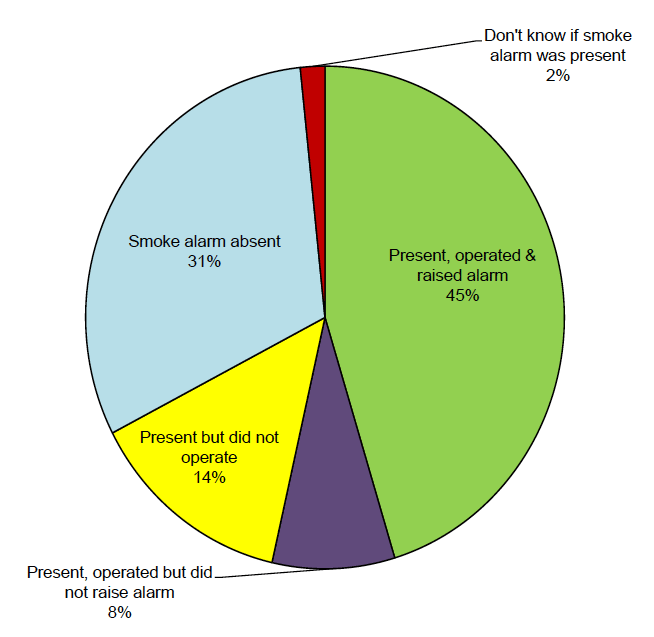
In 2012-13, 13 of the provisional fatal casualties occurred in dwelling fires where there were no smoke alarms (32 %). For the provisional non-fatal casualties, 305 were in a dwelling fire where no smoke alarm was present (26 %).
4.11 Causes and source of ignition of fires (Tables 21, 21a, 22, 23, 24, 24a and 24b)
This year, a new table (Table 22) on source of ignition has been added to this publication. When a fire occurs there is a cause and a source of ignition. For example, if a pan of fat is being heated on a cooker and ignites into a fire, the cause of the fire would be classified as 'Cooking - Chip/fat pan' and the source of ignition would be the cooking appliance - 'Cooker (including oven)'. The source of ignition tends to be the heat source that created the fire, if the cooker had not been on in this example there would have been no fire, as there was no heat source to create the ignition.
In 2012-13, of the 5,820 dwelling fires, the most common cause was 'misuse of equipment or appliance' (41 %) followed by 'deliberate' (14 %). Deliberate dwelling fires were at a ten year low in 2012-13 (Chart 10).
For 2012-13, the most common specific cause of fires in 'Other buildings' was deliberate at 29 %, followed by faulty appliances and leads at 16 %
Chart 10 - Main causes of fires in dwellings (excluding 'others' as a cause), 2003-04 to 2012-13p, Scotland 1
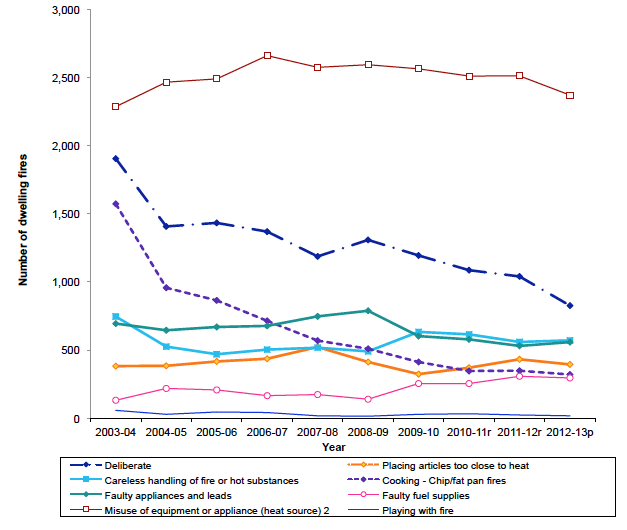
Notes
p - provisional
r - revised
1 - before 2009-10, figures for primary fires are based on sample data weighted to Fire and Rescue Service totals
2 - Under IRS, the category for "Misuse of equipment or appliances" includes incidents which have been recorded as "Other cooking" (a new category introduced with IRS). It is believed that the majority of these incidents were previously recorded as the misuse of cooking appliances under the FDR1 collection
Table B: Top ten sources of ignition in accidental dwelling fires - 2012-13p - Scotland
| Source of ignition |
Number |
Percentage |
|---|---|---|
| Cooking appliance - Cooker incl. oven |
1,907 |
38% |
| Cooking appliance - Grill/Toaster |
491 |
10% |
| Cooking appliance - Ring/hot plate (separate appliance) |
405 |
8% |
| Electricity supply - Wiring, cabling, plugs |
373 |
7% |
| Smoking related - Smoking materials |
350 |
7% |
| Cooking appliance - Microwave oven |
187 |
4% |
| Not known/other |
183 |
4% |
| Heating equipment - Heating/Fire |
176 |
4% |
| Candles |
107 |
2% |
| Other domestic style appliance - Tumble dryer |
82 |
2% |
In 2012-13, the top cause of ignition in accidental dwelling fires was 'Cooker (including oven)' at 38 %. When all types of cooking appliances are summed together these were the source of ignition in 61 % of accidental dwellings fires (3,034).
A new standard for cigarettes has been created in the United Kingdom. On 31 December 2010, the British Standards Institution (BSI) published the standard BS EN 16156 ("Cigarettes - Assessment of the ignition propensity - safety requirement") based on the European standard created earlier that year. From 17 November 2011 all cigarettes manufactured in Europe had to meet these new EU safety standards.
As a result of the required EU standard, cigarette paper manufacturers changed their paper production to insert two rings of thicker paper at two points along the cigarette. If the cigarette is left unattended, the burning tobacco will hit one of these rings and should then self-extinguish because the ring restricts the oxygen supply thus creating a cigarette with a reduced ignition propensity.
Reduced ignition propensity (RIP) cigarettes were introduced to Scotland in the last 4 months of 2011-12. The figures for 2012-13 are the first complete financial year of reporting with this new standard.
Cigarettes are recorded as part of 'smoking materials' and there was a decrease of 32 accidental dwelling fires with this source of ignition between 2011-12 (382) and 2012-13 (350). Over the last 4 years smoking materials have consistently been the ignition source of 7 % of all accidental dwelling fires. As this is the first full year of this standard we are unable to tell if this decrease is part of a downward trend. This will be monitored in the future.
In 2012-13, 41 % of fatal casualties occurred in accidental dwelling fires which arose due to careless handling of fire or hot substances (15 of 37 fatal casualties). Smoker's materials and matches were the main source of ignition in 46% (17 of 37 fatal casualties).
The main cause of accidental dwelling fires where non-fatal casualties occurred was misuse of equipment or appliance 36 % (367), whereas cooking appliances accounted for 59 % (600) of the main source of ignition in accidental fires where a non-fatal casualty occurred.
With the introduction of IRS in 2009, FRSs started to record where there was the suspected influence of alcohol/drugs involved in a fire. In 2012-13 there were 775 (16%) accidental dwelling fires where impairment due to suspected alcohol and /or drugs use was a contributory factor to the fire. This was a decrease of 10 % on last year's figure of 865.
It should be noted that if a fire is suspected to have been influenced by impairment due to alcohol and/or drugs, this does not imply that all casualties were under the influence of alcohol and/or drugs.
In these type of accidental dwelling fires, in 2012-13, there were 10 fatal casualties and 277 non-fatal casualties. These figures decreased from 2011-12, where there were 14 fatal casualties and 298 non-fatal casualties.
4.12 Spread of fire and number of appliances attending fires (Tables 25, 26 and 26a)
With changes to recording through the IRS system, a new category 'smoke and/or heat damage only' has been included in spread of fire (see section 6.5.3 vi for details), which has affected the long term trend data. For 2012-13, 44 % (2,535) of fires in dwellings were reported with smoke and heat damage only. Of the 56 % of incidents in dwellings where flames were reported (3,285), the largest proportion of the fires were 'confined to the item first ignited' (46 %).
In 2012-13, the majority of primary fires were attended by no more than 2 appliances (77 %). There were 137 primary fires in Scotland that required more than 5 appliances which accounts for 1 % of all primary fires.
The majority of secondary fires in 2012-13 were attended by 1 appliance (84%). The majority of secondary fires were outdoor refuse fires.
4.13 Time of call to fires (Tables 27, 27a and 28)
For 2012-13 the number of call outs to primary fires generally peaked between early and late evening (5 pm to 9 pm) at over 700 incidents an hour. Scotland's busiest hour for call outs to primary fires was 5 pm to 5:59 pm (745 or 7 %).
Call outs to dwelling fires peaked between 4 pm and 9 pm in 2012-13. Other building fires were more evenly distributed throughout the day, though there were over 140 incidents between 4 pm to 5 pm and 7 pm to 9 pm., whereas primary outdoor fires generally occurred between 7 pm and 1 am. (Chart 11)
Chart 11 - Primary fires by location and time of call, Scotland, 2012-13p
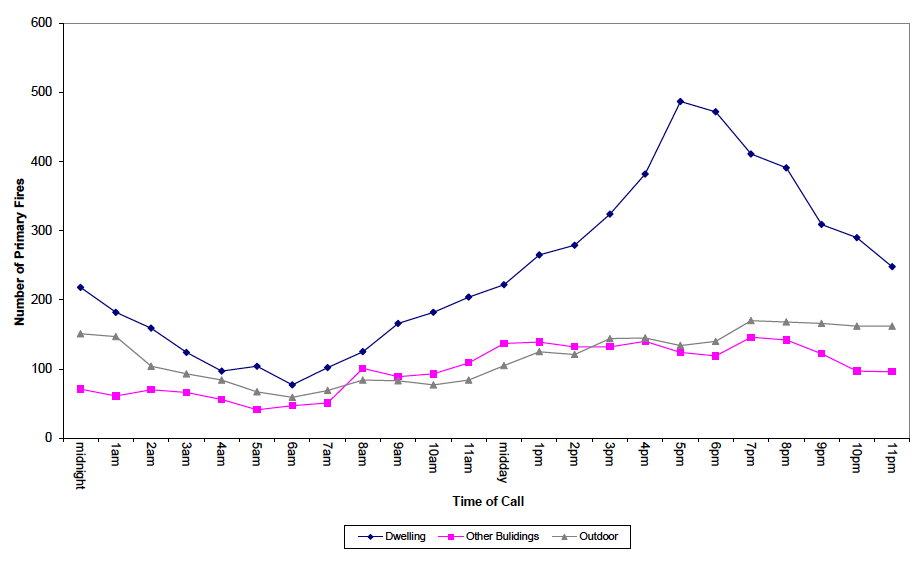
Chart 12 - Rate of fatal and non-fatal casualties per 1,000 primary dwelling fires by time of call Scotland, 2012-13 p
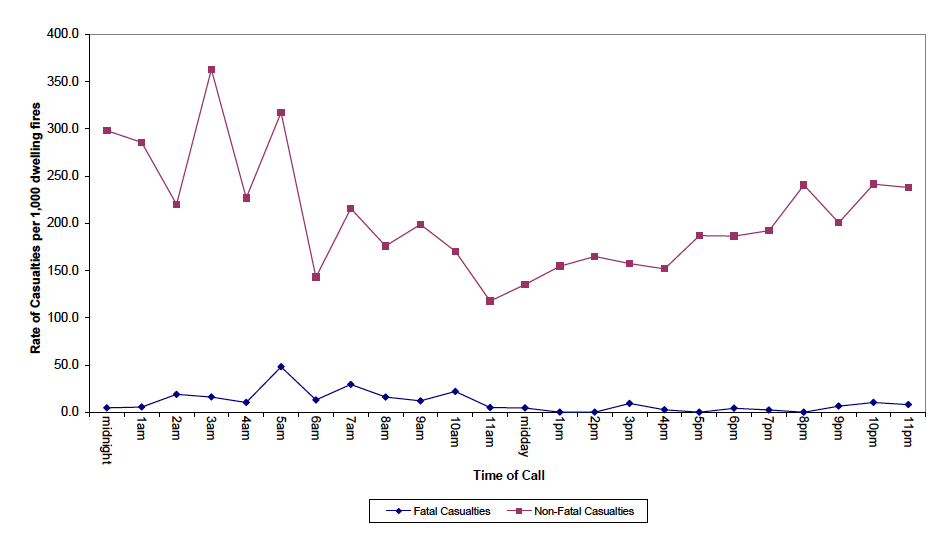
The rate of non-fatal casualties per 1,000 dwelling fires peaked twice in 2012-13 from 3 am to 4 am and 5 am to 6 am with more than 300 non-fatal casualties per 1,000 dwelling fires. (Chart 12)
The numbers of dwelling fires were greater in the evening but the rate of casualties per 1,000 dwelling fires increased between late afternoon and early-morning.
Contact
Email: Lindsay Bennison
There is a problem
Thanks for your feedback